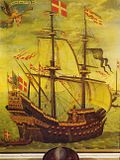 Malta is an exceptionally interesting place in terms of prehistoric archaeology, as by 3,500BC its inhabitants (originally from Sicily) had already started building massive buildings, bigger that anywhere else at the time. Today, these are the oldest megalithic structures in the world. Yet, the civilisation that created them ended abruptly in some inexplicable way around 1,800BC. Malta became again important when the Phoenicians colonised it in 1,200BC. That's probably who the Maltese got the roots of their unique language from. They are also devout Christians, particularly proud that around 58AD, after being shipwrecked on the island as a prisoner of the Romans, St. Paul stayed for three months and introduced Christianity to the people.
Malta's history is largely undocumented in the next centuries, when it was under Roman, later possibly Ostrogoth and then Arab rule. These were followed by Normans, Anjevins, Aragonese and others. Fittingly, it was the multinational monastic Order of the Knights of St. John that made the place legendary.
Malta is an exceptionally interesting place in terms of prehistoric archaeology, as by 3,500BC its inhabitants (originally from Sicily) had already started building massive buildings, bigger that anywhere else at the time. Today, these are the oldest megalithic structures in the world. Yet, the civilisation that created them ended abruptly in some inexplicable way around 1,800BC. Malta became again important when the Phoenicians colonised it in 1,200BC. That's probably who the Maltese got the roots of their unique language from. They are also devout Christians, particularly proud that around 58AD, after being shipwrecked on the island as a prisoner of the Romans, St. Paul stayed for three months and introduced Christianity to the people.
Malta's history is largely undocumented in the next centuries, when it was under Roman, later possibly Ostrogoth and then Arab rule. These were followed by Normans, Anjevins, Aragonese and others. Fittingly, it was the multinational monastic Order of the Knights of St. John that made the place legendary.

In 1565, the Sultan was now in his 70s and determined to destroy the nuisance of the Knights of St. John once and for all. Also, if he had Malta, Suleiman would be able to launch an attack against Western Europe. Through a network of spies and Christian merchants in Constantinople, the Order's Grand Master, Jean Parisot de la Valette, was kept up to date of Suleiman's preparations for war. He intensified the preparation of defences on the island and sent emissaries to ask for help from around Europe. However, most European rulers expected the island to fall and did not want to send their troops to a suicide mission, leaving the 700 knights effectively alone against the most powerful empire in the world. They also feared they would be Suleiman's next targets and they did not have troops to spare. After all, most of the Knights were French, but France was an ally of the Turks at the time.
The Turks landed at Marsasirocco Bay near what is now the picturesque fishing village of Marsaxlokk:
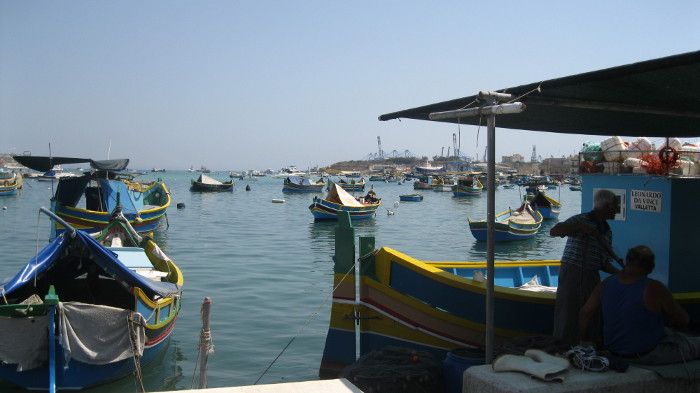
| The two sides at the 1565 siege of Malta |
 Jean Parisot de la Valette. 69 years old. He was fluent in Italian, Spanish, Greek and Arabic, and could speak Turkish which he learned as a slave. In 1545 his galley had been captured by Kurst Ali. He spent the next year as a Turkish galley slave, chained to a bench with five others, rowing for 10-20 hours a day and given only bread soaked in wine when he looked likely to faint. He met the enemy pirate Dragut during this time. La Valette was finally freed at a prisoner exchange. In 1554, he met Kurst Ali again, but this time he won the battle and it was he who sent his enemy captive to his galleys. In 1557, La Valette was unanimously elected Grand Master of the Order. Jean Parisot de la Valette. 69 years old. He was fluent in Italian, Spanish, Greek and Arabic, and could speak Turkish which he learned as a slave. In 1545 his galley had been captured by Kurst Ali. He spent the next year as a Turkish galley slave, chained to a bench with five others, rowing for 10-20 hours a day and given only bread soaked in wine when he looked likely to faint. He met the enemy pirate Dragut during this time. La Valette was finally freed at a prisoner exchange. In 1554, he met Kurst Ali again, but this time he won the battle and it was he who sent his enemy captive to his galleys. In 1557, La Valette was unanimously elected Grand Master of the Order.
In addition to his 700 Knights, he had the support of the native Maltese and a few mercenaries. A total of 8,500 men Suleiman did not personally lead the invasion. He sent instead Mustapha Pasha and Piyale Pasha, together with Dragut Rais. The Turkish force was around 40,000 men, including 6,300 elite Janissaries carrying the most modern firearms, 3,900 fanatical Iayalars who would take hashish before battle and charge regardless of casualties, 9,000 regulars, 6,000 levies, as well as sailors, support troops, and an impressive array of siege weapons, including  some of the largest cannons in the world. The Turks were very experienced soldiers, having already captured most of the Middle East, North Africa and the Balkans. some of the largest cannons in the world. The Turks were very experienced soldiers, having already captured most of the Middle East, North Africa and the Balkans.
Lala Kara Mustafa Pasha. 65 years old. A veteran of several campaigns, including Rhodes. Skilled, but also renowned for his brutality, he was determined to finish the job that should have finished in Rhodes.  Admiral Piyale Pasha. 50 years old. Born a Christian, he was found by the Turkish army as a child abandoned outside the besieged Belgrade. Suleiman brought him up in his own harem and later married him to his grand daughter. By 1565, he had proved to be a skilled naval commander. Admiral Piyale Pasha. 50 years old. Born a Christian, he was found by the Turkish army as a child abandoned outside the besieged Belgrade. Suleiman brought him up in his own harem and later married him to his grand daughter. By 1565, he had proved to be a skilled naval commander.
Dragut Rais. 80 years old. Born a peasant, he impressed a local governor with his intelligence and was taken to Egypt to be educated. He served first as a Mameluke gunner and later under  the famed pirate Barbarossa, who he succeeded in 1545. Both Muslims and Christians praised him for his intelligence, knowledge of the Mediterranean, courage, use of science, and exceptional ability to escape peril in unexpected ways. He did not have operational command during the Siege of Malta, but was effectively representing Suleiman and was respected by the two commanders. the famed pirate Barbarossa, who he succeeded in 1545. Both Muslims and Christians praised him for his intelligence, knowledge of the Mediterranean, courage, use of science, and exceptional ability to escape peril in unexpected ways. He did not have operational command during the Siege of Malta, but was effectively representing Suleiman and was respected by the two commanders.
|
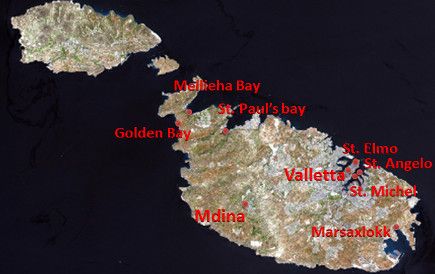
Malta's old capital was Mdina ("City" in Arabic), but the Knights
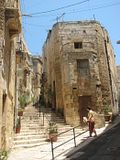 chose to settle at the small village of Birgu, next to the harbour, and built the fort of St. Angelo separated from the town by a small canal. They also built fort St. Michel and St. Elmo. The latter did not have an adjacent town and was impossible to send reinforcements and supplies to it. For this reason, the Turks attacked it first expecting it to fall very quickly. Despite the constant bombardment and well-coordinated attacks, it took a whole month and 8,000 Turkish to 1,500 Christian casualties to capture St. Elmo. The Knights there were so exhausted by that time that it is said that the last two commanders were fighting from their chairs when the Turks burst in. Only five Maltese soldiers survived by swimming to the other side of the harbour. On that day, the Turks also lost Dragut Reis who had been seriously wounded by a rock splinter thrown up by a cannon-ball, effectively losing the only commander who could co-ordinate land and naval forces. The next day, the knights of St. Angelo woke to the sight of the naked decapitated bodies of their brothers at St. Elmo nailed to wooden crosses. La Valette responded by ordering his cannon to fire on the Turks with the heads of Turkish prisoners rather than cannon-balls. It was a clear signal that this was a fight to the death from both sides.
chose to settle at the small village of Birgu, next to the harbour, and built the fort of St. Angelo separated from the town by a small canal. They also built fort St. Michel and St. Elmo. The latter did not have an adjacent town and was impossible to send reinforcements and supplies to it. For this reason, the Turks attacked it first expecting it to fall very quickly. Despite the constant bombardment and well-coordinated attacks, it took a whole month and 8,000 Turkish to 1,500 Christian casualties to capture St. Elmo. The Knights there were so exhausted by that time that it is said that the last two commanders were fighting from their chairs when the Turks burst in. Only five Maltese soldiers survived by swimming to the other side of the harbour. On that day, the Turks also lost Dragut Reis who had been seriously wounded by a rock splinter thrown up by a cannon-ball, effectively losing the only commander who could co-ordinate land and naval forces. The next day, the knights of St. Angelo woke to the sight of the naked decapitated bodies of their brothers at St. Elmo nailed to wooden crosses. La Valette responded by ordering his cannon to fire on the Turks with the heads of Turkish prisoners rather than cannon-balls. It was a clear signal that this was a fight to the death from both sides.

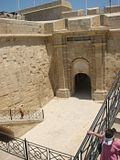 St. Angelo and St. Michel were much better placed, as they could be reinforced through Birgu and could communicate with each other. St. Michel on its own withstood 10 large-scale assaults during the siege. At some point, the Turks brought a siege tower and almost managed to enter the walls, as it was covered with wet leather and even the Knights' Greek fire was ineffective against it. After consulting with his master carpenter, La Valette ordered a secret artillery position to be prepared, facing the tower's base through a hole in the wall. The final stone of that hole was pushed at the last minute and the cannon fired at the tower's base to bring the whole structure down. The plan worked and the Knights were saved to fight another day. In the end, none of the two forts fell although both were in desperate condition. Today both St. Angelo and St. Michel look spectacular, especially at night from the Barrakka gardens. Notice how close to each other they are. When there was no moon, the defenders could swim from the one to the other:
St. Angelo and St. Michel were much better placed, as they could be reinforced through Birgu and could communicate with each other. St. Michel on its own withstood 10 large-scale assaults during the siege. At some point, the Turks brought a siege tower and almost managed to enter the walls, as it was covered with wet leather and even the Knights' Greek fire was ineffective against it. After consulting with his master carpenter, La Valette ordered a secret artillery position to be prepared, facing the tower's base through a hole in the wall. The final stone of that hole was pushed at the last minute and the cannon fired at the tower's base to bring the whole structure down. The plan worked and the Knights were saved to fight another day. In the end, none of the two forts fell although both were in desperate condition. Today both St. Angelo and St. Michel look spectacular, especially at night from the Barrakka gardens. Notice how close to each other they are. When there was no moon, the defenders could swim from the one to the other:
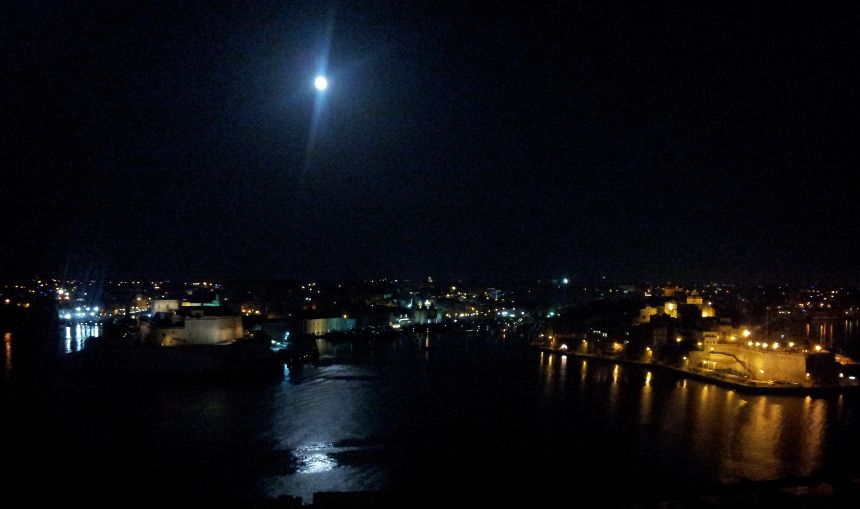
During the siege, Mdina had only a small cavalry force, but the Turks had decided to ignore it and go directly for the main forts. This proved to be a mistake. At the exact moment that the Turks broke the defences of St. Michel and were inside the fort, they received reports of a force raiding their camps. Fearing that this must be Christian reinforcements from Sicily, the Turks retreated, only to find out that it was only the small Mdina cavalry force. By then it was too late. The Knights had been saved once again and had time to repair their walls. Today, Mdina is still pretty much the way it looked at the time of the Knights:
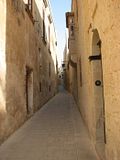
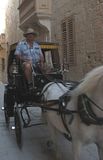
Finally, after months of procrastination and delay, the Viceroy of Sicily came to the rescue with 10,000 troops, including 200 Knights, landing at the sandy beach of Mellieha Bay. This was the beginning of the end of the siege as the exhausted Turks had lost their will to fight. After one more disastrous battle, where they were decimated against the fresh troops from Sicily, they packed up and left for Constantinople.
After the siege, the Knights were convinced that they had finally found the place that they could call their home and La Valette started building a modern town next to St. Elmo, on the hill where the
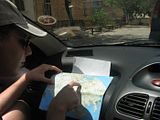 Turks had attacked from. The town was named Valletta and is still Malta's capital. It was one of the first towns in the world with a grid layout. Even today this makes Valletta very easy to navigate on foot, albeit not as easy by car due to the restrictive one-way system and narrow roads. While the town was still being made flat, reports started coming from Constantinople of a new invasion, this time led by Suleiman himself. Priorities in Valletta changed, and as there was not time to finish the nice flat layout, the outer streets fall steeply to the shore. This would also allow for better defence in case of invasion, but makes life difficult for tourists:
Turks had attacked from. The town was named Valletta and is still Malta's capital. It was one of the first towns in the world with a grid layout. Even today this makes Valletta very easy to navigate on foot, albeit not as easy by car due to the restrictive one-way system and narrow roads. While the town was still being made flat, reports started coming from Constantinople of a new invasion, this time led by Suleiman himself. Priorities in Valletta changed, and as there was not time to finish the nice flat layout, the outer streets fall steeply to the shore. This would also allow for better defence in case of invasion, but makes life difficult for tourists:
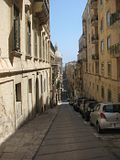
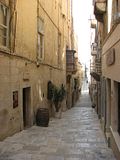
The second attack never came as Suleiman died on an expedition to Hungary and his son was not interested in Malta.
A few years later, the Knights built St. John's Co-Cathedral in Valletta, one of the most impressive Baroque buildings in the world:
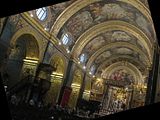
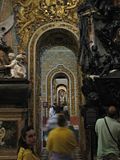
The Grand Master's palace and armoury are also worth visiting. The photo on the right shows the armour of Grand Master Alof de Wignacourt:
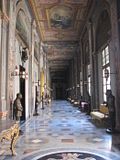

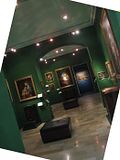 Influenced by Italy and the Knights, who were big patrons of the arts, Malta has a strong tradition in singing and the fine arts. They have produced accomplished opera singers, such as Joseph Calleja, and their big-boned Chiara Siracusa has made an impression with her four Eurovision appearances, including a second place below Greece's Elena Paparizou in 2005. There are also a good number of art galleries and exhibitions, including the museum of fine arts and an exhibition for Mattia Pretti, who has done several of the paintings in St. John's co-Cathedral. Possibly Caravaggio's greatest work is the Beheading of Saint John the baptist, commissioned by the Knights as an altarpiece:
Influenced by Italy and the Knights, who were big patrons of the arts, Malta has a strong tradition in singing and the fine arts. They have produced accomplished opera singers, such as Joseph Calleja, and their big-boned Chiara Siracusa has made an impression with her four Eurovision appearances, including a second place below Greece's Elena Paparizou in 2005. There are also a good number of art galleries and exhibitions, including the museum of fine arts and an exhibition for Mattia Pretti, who has done several of the paintings in St. John's co-Cathedral. Possibly Caravaggio's greatest work is the Beheading of Saint John the baptist, commissioned by the Knights as an altarpiece:

Caravaggio was notorious for brawling and would regularly be caught by the police for various offences. In 1606, he killed a young man in Rome, possibly unintentionally. While for lesser crimes his powerful patrons would have protected him, this was too much, and he fled to Naples and then Malta, where he hoped that the patronage of the Grand Master of the Knights would help him secure a pardon for his conviction in Rome. The Grand Master was so impressed by his work that he made him the official painter of the Order and inducted him as a knight. Yet, in 1608 Caravaggio was again arrested and imprisoned for an incident where a knight was seriously wounded. By the end of the year he had been expelled from the Order "as a foul and rotten member".
The fine arts tradition is still strong in Malta. In fact, one of the local artists, Selina Scerri was performing jointly with a music band outside our restaurant while we were having our nice rabbit stews and seafood pastas:
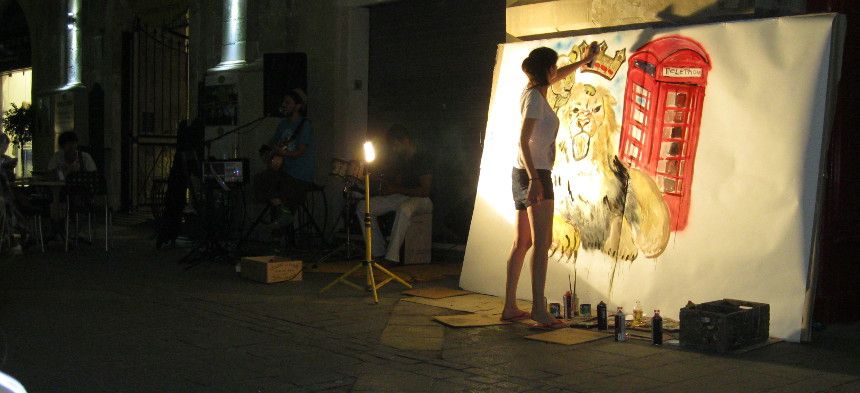
The Knights' reign ended in 1798 when Napoleon Bonaparte stopped there en route to Egypt. After being denied access to resupply his ships, he sent his troops and captured Valletta. During his very short stay of only six days, Napoleon created a public finance administration, abolished all feudal rights and privileges, abolished slavery and granted freedom to all Turkish slaves, framed a family code, nominated twelve judges, organised public education based on the French system of primary and secondary education, and founded fifteen primary schools and an ’Ecole centrale’ with an emphasis in science. The Maltese were initially optimistic, but the French started closing convents and seizing church treasures, including the sword of Grand Master la Valette, which is today exhibited in the Louvre. The Maltese rebelled and asked for British assistance, with Nelson blockading the island and forcing the French garrison to surrender in 1800.
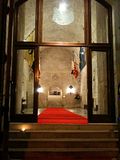
In 1834, the Pope resurrected the Sovereign Military Hospitaller Order of Saint John of Jerusalem of Rhodes and of Malta, with hospital work and charity as their main concern. At the same time, the Order retains its military role, as an auxiliary medical and paramedical corps in the Italian army. The photo on the right shows the entrance of their embassy in Valletta. They are recognised as an independent country by the Vatican and a few other Catholic countries.
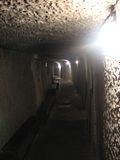 During World War II, Malta was again at a strategic position, as it could effectively act as an unsinkable aircraft carrier in the middle of the Mediterranean. After an ineffective light bombing from the Italians, the Germans took over the assault and dropped in total more bombs than on London and Coventry together. To survive, the Maltese built underground catacombs with their hands, as they did not have access to machinery. These could hold all 250,000 of their population. We had the pleasure to visit one of these catacombs and get an idea of how difficult life must have been in there.
During World War II, Malta was again at a strategic position, as it could effectively act as an unsinkable aircraft carrier in the middle of the Mediterranean. After an ineffective light bombing from the Italians, the Germans took over the assault and dropped in total more bombs than on London and Coventry together. To survive, the Maltese built underground catacombs with their hands, as they did not have access to machinery. These could hold all 250,000 of their population. We had the pleasure to visit one of these catacombs and get an idea of how difficult life must have been in there.

On 15 April 1942, King George VI awarded the George Cross "to the island fortress of Malta — its people and defenders" so as to "bear witness to the heroism and devotion of its people" during the great siege in World War II. The George Cross is depicted on the top left side of the Flag of Malta.
 Malta's Grand Harbour has been used by various nations' warships for hundreds of years. When we visited it, we spotted the French anti-air frigate Forbin (D620) there.
Malta's Grand Harbour has been used by various nations' warships for hundreds of years. When we visited it, we spotted the French anti-air frigate Forbin (D620) there.
History aside, Malta is a wonderful place to spend 3-4 days of one's vacations. The restaurants at the Grand Harbour serve proper Mediterranean food and there is a good range of beaches to choose from:
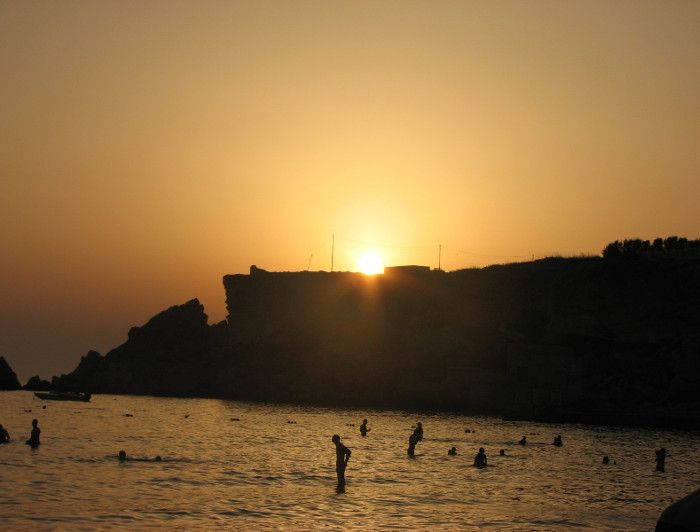
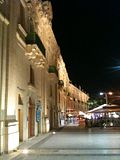
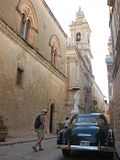
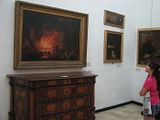
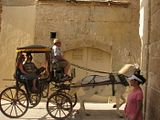

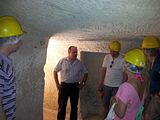
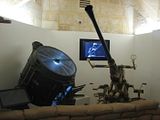


 The Knights of St. John were monks that also took the responsibility of caring for the sick and protecting pilgrims during the age of the crusades. They were all of noble birth, coming from the most powerful families in Europe. As they were monks, they were bound by vows of poverty, chastity and obedience. They quickly gained fame as a formidable military force with several successes against muslim armies, and at the height of the Christian Kingdom of Jerusalem, they held seven great forts and 140 other estates in the area. When all Christians were expelled from Palestine, the Knights moved to Cyprus and then Rhodes, where they built the most splendid fortifications in the Mediterranean. They became a naval force that protected Christian ships and attacked Muslims at every opportunity, until Suleiman the Magnificent, the 26 year-old Ottoman Sultan, finally broke them and conquered Rhodes. He was so impressed by their courage that he let them leave the island honourably with all their sacred relics, banners and arms, and spread around Europe expecting that this would be the end of the Order. Indeed, they had almost disintegrated by 1530, when the Holy Roman Emperor Charles V gave them the islands of
The Knights of St. John were monks that also took the responsibility of caring for the sick and protecting pilgrims during the age of the crusades. They were all of noble birth, coming from the most powerful families in Europe. As they were monks, they were bound by vows of poverty, chastity and obedience. They quickly gained fame as a formidable military force with several successes against muslim armies, and at the height of the Christian Kingdom of Jerusalem, they held seven great forts and 140 other estates in the area. When all Christians were expelled from Palestine, the Knights moved to Cyprus and then Rhodes, where they built the most splendid fortifications in the Mediterranean. They became a naval force that protected Christian ships and attacked Muslims at every opportunity, until Suleiman the Magnificent, the 26 year-old Ottoman Sultan, finally broke them and conquered Rhodes. He was so impressed by their courage that he let them leave the island honourably with all their sacred relics, banners and arms, and spread around Europe expecting that this would be the end of the Order. Indeed, they had almost disintegrated by 1530, when the Holy Roman Emperor Charles V gave them the islands of 